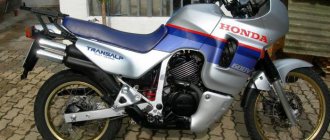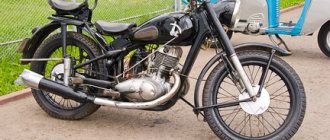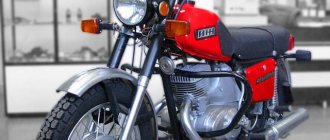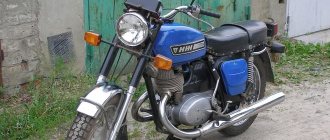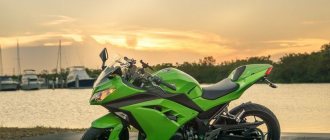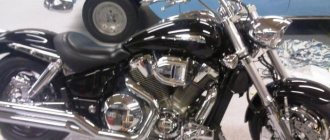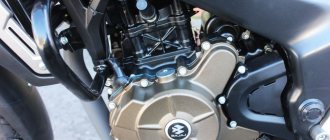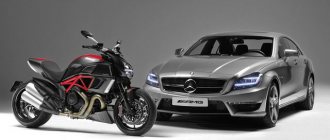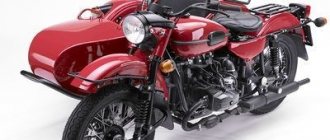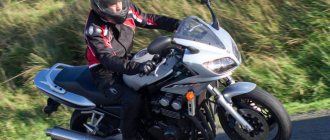In any Russian motorcycle showroom you can see a couple of small-capacity Chinese sportbikes, and, quite possibly, one of them will be the Patron Sport 250. At the first glance at it, you get the strong impression that we have already seen all this somewhere, as if Chinese designers pulled a little bit of ideas from everywhere - some were taken from the Yamaha R1, some from Honda from the CBR line, and some from the famous “Jixers” from Suzuki. The final result, subjectively, does not look very organic, and it really seems as if the Patron Sport 250 was assembled from different pieces, somehow fitted to each other. Apparently the Chinese were inspired by all Japanese sportbikes at the same timeoh, and they took motorcycles from the 90s as a basis, and not more modern ones.
Design, of course, is a subjective thing, but in the case of the Patron Sport 250 motorcycle it is difficult to attribute it to its advantages. The rough plastic was somehow adjusted, but an organic silhouette still did not work out. A faceless front fairing with two headlights, bolt heads protruding from the body kit elements - what kind of aesthetics can we talk about here? It seems that Patron Sport was assembled solely on the principle of “ if only it was cheaper .” However, given the really low price of this bike, perhaps this is not far from the truth. The budget nature of the Patron Sport 250 is striking at the first meeting with this motorcycle. The plastics are thin and probably not very flexible, the seats are covered in slippery and tatty young dermantine leather, and the dashboard is featureless and indistinguishable from those on millions of other Chinese bikes. However, enough about the appearance, let's see what the Patron Sport 250 motorcycle is in terms of design.
Technical characteristics of Racer Phantom 250
Since the Chinese are positioning their brainchild as a sports tourist, we will evaluate it accordingly, without discounts or concessions. What do buyers get for a relatively modest price? And what they get is, in general, a good motorcycle, albeit a little archaic. Designers from the Middle Kingdom clearly saved on materials, trying to keep the cost of production of the Racer Phantom 250 at an affordable level, and therefore decided to use a conventional steel frame instead of a light alloy one, which affected the weight of the motorcycle. The power unit is a 1-cylinder, 4-valve liquid-cooled engine (27.2 hp and 23 Nm), which must be turned in order to feel the dynamics and reach a maximum speed of 120 km/h. By the way, the Racer Phantom 250 reaches the declared “maximum speed” without problems, and the engine does not bother with vibrations even at high speeds. The transmission is quite modern, 6-speed.
The brakes also deserve the most positive feedback. The front wheel has two brake discs with 2-piston calipers, and at the rear there is another disc, also with a 2-piston caliper. As a result, the Racer Phantom 250 brakes excellently. Since there is no ABS system on the motorcycle, there is a risk of the wheels locking, but it would be reckless to expect ABS on a budget Chinese bike. But the Racer company was generous with an upside-down fork with adjustable stiffness! True, it is still too soft, even in the maximum tightened position - apparently, it is designed for puny Chinese, and not for strong Russians. The problem is partly eliminated by replacing the fork oil with a harder one.
The seating position on the Racer Phantom 250 corresponds to the title of a sports tourist; the triangle of clip-ons, footrests and seat is perfectly aligned. Most motorcyclists will probably find the seating position quite comfortable, and you can ride a couple of hundred kilometers without getting tired at all. Moreover, the motorcycle has some kind of wind protection, and for the speeds that it is capable of developing, it is more than enough. And you won’t have to stop often, since it’s not so easy to make the Racer RC250NC-X1 Phantom consume more than 4 liters of gasoline per hundred kilometers.
Technical specifications
The transmission of the motorcycle has a five-speed gearbox. Gears change with ease. Typically, fifth gear is only needed for highway driving. The engine is started in two ways: with an electric starter. As for the instrument panel, it is informative: speedometer, tachometer, engine overheating sensor, gear indicator, fuel level indicator in the tank, turn signal indicator. The devices have blue backlighting, which does not blind the driver when driving at night. The brakes on the motorcycle are hydraulic discs with a 2-piston caliper. The diameter of the brake disc of the front wheel is 300mm, the rear one is 240mm. This significantly increases braking efficiency and also allows you to ride a motorcycle in urban environments without any problems. The Patron Sport 250 motorcycle is considered economical, because gasoline consumption per 100 km is 4 liters. The maximum speed of this motorcycle model is 110 km/h. The motorcycle has excellent ergonomics. Everything is in its place. After all, you don’t have to reach out to, for example, open the choke, because everything is at hand. The fuel tap on a motorcycle is automatic, which opens when the engine starts, and you don’t need to think whether the gas tap is closed. This is a great advantage.
If we talk about maintenance, then this model requires special attention. This is present for the first time after purchasing a motorcycle.
The price of motorcycles from this manufacturer starts from 25,000 rubles, but the model of the equipment should be taken into account. For example, you can buy a Patron Sport 250 for 125,000 rubles.
Similar models
- Genata YZF-R 250 . Another Chinese sportbike, both in appearance and name, trying to be similar to its famous Japanese counterparts. With the same mediocre success.
- Minsk 250 R. A very good lightweight motorcycle, designed in China and assembled in Belarus. It is almost twice as powerful as the Patron Sport 250 and costs one and a half times more. A very interesting specimen in its class.
- Falcon Speedfire 250 Sport . In both price and technical characteristics, it is almost no different from the Patron Sport 250, but subjectively it looks more interesting.
Chassis
The basis of the machine is a conventional steel frame with a duplex design. The rear wheel suspension system uses a single shock absorber, which improves the machine's handling and simplifies design and maintenance. The front fork is equipped with two gas-oil struts. All 250 Sport models are equipped as standard with three-spoke alloy wheels (17-inch wheel diameter). Due to this, it was possible to keep the weight to just 138 kg, which ensured good dynamics of the motorcycle.
The sporty appearance of the car is also emphasized by the brake system with hydraulic drive of the actuators. The front wheel is equipped with a disc brake with a working element diameter of 300 mm. The brake design on the rear wheel is similar, but has a slightly smaller diameter (only 240 mm). Calipers with two working pistons installed on the machine allow for predictable deceleration of the motorcycle over the entire speed range.
Engine
The motorcycles are equipped with a single-cylinder air-cooled engine with a displacement of only 233 cubic meters, so they cannot be called full-fledged 0.25-liter machines. The engine itself has a fairly modern design with a four-stroke gas distribution circuit, which provides acceptable technical characteristics of the “Patron 250 Sport”. The engine is started under normal operation using an electric starter.
The valves (there are only two) and the drive shaft are installed in the head. The shaft drive is carried out by a chain, which has compensation systems for increasing length during operation. At the bottom of the crankcase there is a reservoir for the lubrication system, which is supplied to the engine components using a pump. In addition to its lubricating function, oil removes excess heat from components, which helps improve engine performance and increase its service life. A small radiator is installed to cool the oil. The design of the engine made it possible to obtain power of almost 16 forces at a speed of about 7500 per minute.
In the same block with the engine there is a five-speed gearbox with a foot shift lever. With an unworn clutch and careful operation, shifting is very easy. A classic chain drive is installed between the gearbox and the rear wheel. In urban driving, fifth gear is used extremely rarely. It is only advisable when driving at speeds close to the limit values.
Reviews from Patron Sport 250 owners
I bought a used Cartridge for 50 thousand secondhand, with a children's mileage of 3000 km, applied slightly to one side. I soldered the plastic myself, because... I can do it, it turned out fine, after repainting you couldn’t even see the seams. Plastic, by the way, breaks like glass, but can be repaired without any problems using staples and a soldering iron. The motorcycle is generally ok, it rides, but it doesn't give up. There is enough tuning for Ali, but I didn’t spend money, I just bought a top case with fasteners. The road is noticeably swayed by the side wind and cars flying past. Maintenance is simple. As a first bike, the Patron Sport, IMHO, will do, but it will get boring quickly. I got tired of it after a season. Vadim, Moscow, Patron Sport 250 '2012.
A real small sportbike, absolutely super for the price, I bought it new at the time and with a guarantee, rode it for two years, then switched to a Zizer 400. I drove about 9k km during this time, there were no problems, I started running it after 1k km. I tightened the loose nuts myself and immediately replaced the original oil with Liquid Moly. The motorcycle is reliable, no complaints. Ivan, Voronezh, Patron Sport 250 '2013.
Personally, after one full season, the Patron 250 Sport left me with mixed impressions. It seems to look good, but if you take a closer look - well, China is China. It starts to accelerate vigorously, but deflates quickly; wind protection at such speeds is not needed at all. It’s good for beginners to learn how to drive, if anything, and it’s not a pity to put in the effort, plastic all around costs about five hundred bucks. Rinat, Volgograd, Patron Sport 250 '2015.
Advantages and disadvantages of the model
The motorcycle is equipped with a rather unpretentious 125 cc air-cooled engine. see. The manual transmission has 5 speeds, so choosing the required speed mode with minimal fuel consumption is not a big problem. Accelerating a motorcycle to the maximum speed according to the passport (90 km/h) is also quite possible.
Other advantages include the suspension system (telescopic front and pendulum rear), which, despite its simplicity of design, copes well with road irregularities.
The ground clearance is 125 mm and the fuel tank has a capacity of 8.5 liters. With an average consumption of about 2.5 liters per 100 km, a distance of approximately 350 km can be covered on one gas tank fill.
Among the electronic “assistants”, it is worth noting the presence of a tachometer on the dashboard, which will allow you to select the optimal driving mode, in which fuel consumption outside the city limits will be extremely minimal, which further increases the average range of motor vehicles of this type.
Now about the disadvantages... Due to the cheaper design, the brakes had to be “sacrificed”, so the bike has drum brakes both front and rear.
Some owners are also bothered by the location of the exhaust pipe, which is not protected from accidental contact.
After a long trip, the muffler gets very hot and if you are careless, you can accidentally burn your leg.
In general, you can find fault with any equipment, but if a person monitors its condition and carries out maintenance on time, then there will be no serious problems with this motorcycle.
Minor breakdowns from reviews on the Internet include the following: clutch and gas cables “fly”, light bulbs burn out, fork seals leak, shock absorbers do not work. Sometimes there are cases when, even with a moderate driving style, the spokes on the wheel “rip out” and the muffler becomes clogged. All these problems are usually solved by replacing them with inexpensive domestically produced spare parts. For example, the clutch cable can be supplied from a Java motorcycle, the chain from a Voskhod.
Comfortable trips
The shape of the fuel tank allows you to feel incredibly comfortable when driving. Even how the knees should be positioned can be determined by the presence of special bulges. This ensures a correct fit. But there is also a clear drawback. This convenience is designed exclusively for short people. However, the Chinese auto industry will correct this shortcoming with the release of the next series of motorcycles. The modified shape of the gas tank will allow you to fill it with fuel, which will last for 500-600 kilometers. Moreover, the consumption per hundred kilometers is only 2.5 liters.
The instrument panel and buttons on the steering wheel, as well as the entire motorcycle, are made in a spartan style. The combination of neat execution and ease of use makes this iron horse incredibly convenient.
The only thing missing is the usual red buttons to stop the engine and turn on the hazard lights. The dashboard is an example of a minimum product range. But in addition to the usual speedometer, tachometer and odometer, there is a fuel gauge and a digital display for monitoring the gear engaged. There are no tricks or bells and whistles - everything is done in the “classic” style.
A little history
If you look closely, you can see two names on the tank – Patron and Yingang. Most likely, these two names will tell little to most Russian motorcyclists. To clarify, let's dive headlong into historical facts.
The city of Izhevsk is known throughout Russia thanks to the Ural motorcycle company with six years of experience in withstanding competition in the sales market. For the last two years, the Izhevsk company has been importing motorcycles from China. She also changed the direction of production. Instead of lightweight scooters, powerful “iron horses” are now being produced. What is “Jingang”? This is probably the least known Chinese company. It is not widely popular among consumers. Motorcycles produced by the Yingang company have either clones of Izhevsk engines or lower-shaft Honda engines with a volume of 200 cubic meters. And there are only a few dozen such motorcycles on the market.
“Tucker” became a real pearl in this entire collection of “good” motorcycles. By the way, the original name will sound like this: YC250NF Tracer 250. And the most interesting thing is that the manufacturers from Izhevsk have been persuading their management for a long time to put the “Tucker” into wide production and send it to the market.
Motorcycle design features
The sportsbike “Patron Sport 250” is one of the most popular motorcycles on the market, gaining popularity due to its ease of maintenance and ease of control. The engine cooling system is air-oil, the power unit itself is a single-cylinder four-stroke with a volume of 233 cubic centimeters. Excellent power characteristics allow you to achieve high motorcycle dynamics. The attractive appearance of the model is due to the tinted windshield, which creates a unique and eye-catching design. Comfortable riding and stability on the highway are ensured by an inverted front fork monoshock and a diagonal frame. The motorcycle's seating position is upright, as befits this class. “Patron Sport 250” is equipped with 17-inch wheels and road tires. Alloy wheels reduce the weight of the motorcycle, increasing its top speed and reducing acceleration time.
Motorcycle engine
The most important thing to pay attention to is the engine. The 250 cm3 cubic capacity, rare for the Chinese automobile industry, is equipped with all the technical bells and whistles:
- Liquid cooling.
- Twin-shaft four-valve head.
- Balancer shaft.
- Six-speed gearbox.
The Patron Taker 250 has an engine similar to the old NX250 (it was released in the mid-80s). You should know that the AX-1 (NX250) had 29 horsepower at 8500 rpm. Chinese manufacturers made some improvements and got an engine of 26 “horses” with a number of revolutions per minute of 9000. In this engine:
- 70mm piston (same as NX250);
- piston stroke – 65 mm;
- The engine capacity is even slightly larger than 250 cc. cm.
Despite the fact that the “Chinese” is designed to work with gasoline with an octane rating of more than 90, there was still a slight loss of power.
Motorcycle characteristics
In order for you to get to know the motorcycle better, Patron Taker 250 technical specifications will be presented below.
- The gears are evenly distributed throughout the entire ratio range. The exception is the sixth. You don't have to turn it on at all. Well, perhaps when driving long distances, in order to save gasoline.
- Tires from Kenda. This is a well-known, but no more, manufacturer in Taiwan.
- Load and speed index – 66N. This is enough to travel without a load at a speed of 200 km/h.
- The width of the rear tire is even larger than that of a GS motorcycle (engine capacity - 500 cc).
- The suspensions will not allow you to customize your motorcycle. You can't even change the spring tension.
- Possibility of adjusting the rear shock absorber using a special lever.
- The rear monoshock absorber provides a relatively soft ride even on Russian roads.
For a road motorcycle, all these characteristics can be rated as four (on a five-point scale). It has especially good brakes. In principle, they would be suitable for a more powerful “horse”.
The chain drive does not affect the driving experience in any way. For these motorcycles, it is manufactured using %-inch pitch chain technology. The only negative is that the plates are not thick enough and, moreover, without rings. Just right for an IZH or Java, but they are not suitable for such a motorcycle. The reason is that the chain will have to be tightened every day. That is why professionals recommend that immediately after purchasing the Patron Tucker 250 motorcycle, purchase another chain and immediately replace the original one with it. The remaining characteristics of the Patron Taker 250 allow you to ride without being embarrassed by its archaic appearance. The literal translation of the name is “raider.”
Technical characteristics of Patron Sport 150
The first thing that should alert you when buying a motorcycle that has the word “sport” in its name is the price.
At the time of this writing, this bike costs on average just under a thousand dollars, which is both good and bad. It’s good because the price tag is more than affordable, but it’s bad because for that kind of money you can’t buy a real sportbike, even a small one. However, the Patron Sport 150 is de facto the most ordinary classic “road car”, extremely simple and budget-friendly, and from “sport” it is only in name. So, what do the Chinese offer us? The usual diagonal steel frame, in which a 1-cylinder, 2-valve 150 cc air-cooled engine is placed, is extremely archaic, but, according to reviews, very reliable. It works with a carburetor, a classic 5-speed transmission and a chain wheel drive. Simple, budget-friendly, familiar, there’s simply nothing to add here. The Patron Sport 150 engine can produce 11.3 hp. (at 8500 rpm) and produce a torque of 10 Nm (at 6000 rpm). It has neither lows nor highs, but in the main operating speed range it drives quite confidently, of course, taking into account its cubic capacity. In addition, the dry weight of the Patron Sport 150 does not exceed 115 kg, which also makes a positive contribution to the dynamics. The maximum speed of the Patron Sport 150, declared by the manufacturer, is 95 km/h. Everything is fair - it really accelerates to 95 km/h. True, already at about 70-80 km/h you will have to unscrew the throttle all the way, be patient and firmly withstand the vibrations that appear in abundance after about 6000-7000 rpm. There is no need to be afraid of speed in suitable conditions, since the motorcycle’s brakes are quite good, with brake discs and 2-piston calipers on both wheels.
Otherwise, the Patron Sport 150 motorcycle is also unremarkable. The suspension is simple, without any adjustments other than the pretension of the rear monoshock. An inverted telescopic fork is installed at the front, which, by the way, is surprising given the low cost of this model. But this is a nice feature; there really are no complaints about the performance of the fork. The only criticism concerns the fork oil filled from the factory; it seems too soft. Apparently, it is designed for the weight of the average Chinese driver, and under the tall Russian motorcyclist the Patron Sport 150 immediately sags noticeably. This problem can be resolved easily and simply, just pour harder oil into the fork, and in extreme cases, install other springs; fortunately, tuning is available in bulk on the Patron Sport 150, and it is inexpensive.
Total
We can say that the Patron Sport 250 is another Chinese sportbike in a row of unremarkable analogues from the Middle Kingdom. It cannot be called bad, no, in no case - it is well worth the money that is being asked for it. Another thing is that there are many other motorcycles in the world that are more interesting in many respects. However, giving the Patron 250 Sport the right to exist is also worth it - inexpensive and practical, it can become a faithful friend for a novice motorcyclist .
Technical characteristics of Patron Taker 250
Of course, there are no innovations in this motorcycle, but compared to other handicrafts of Chinese designers, it looks more than worthy. Apparently, craftsmen from the People's Republic of China meticulously studied the popular Japanese small-capacity models, diligently copied successful solutions, made some changes to reduce the cost and offered the Patron Tucker 250 to the public. The experiment can be considered successful - both the technical characteristics of the Patron Taker 250 and its appearance are excellent are in harmony with each other. This is a typical urban street bike, light, maneuverable and surprisingly peppy.
Of course, the Chinese didn’t shell out money for a light-alloy frame, but an ordinary steel frame will suffice for us, right? Moreover, it houses a good 1-cylinder 4-valve liquid-cooled engine capable of producing 25 hp. and 22 Nm of torque. It is mated to a completely modern 6-speed gearbox, which, it should be noted, works without the slightest complaints. At the same time, the dry weight of the Patron Taker 250 does not even reach 150 kg, and its center of gravity is low, so subjectively the motorcycle seems very light. The maximum speed of the Patron Tucker 250 is 140 km/h, and it is really capable of achieving it.
The pendants are also worthy of attention. An inverted telescopic fork is installed at the front, and a pendulum with two energy-intensive shock absorbers at the rear. It seems that the Chinese designers managed to find a balance between comfort and controllability, and it’s impossible to find fault with the Patron Taker 250 suspensions even if you wanted to. The brakes are also good - discs with calipers are installed both front and rear. The only pity is that the injector was not delivered; instead, it was decided to install a conventional carburetor. However, even without an injector, the Patron Tucker 250 can be called a motorcycle that is fully in line with the modern technological level, especially in the budget segment.
Video Review
Specifications
| Maximum engine power: | 15.6 hp at 7500 rpm HP |
| Torque: | 18 N•m at 4500 rpm Nm |
| Working volume: | 233 cm3 |
| Motor type (cylinder arrangement, number of strokes): | 4-stroke, 1-cylinder |
| Number of cylinders: | 1 |
| Number of valves: | |
| Intake type (Injector / Carburetor): | |
| Bore and stroke: | |
| Starting system (Electric starter, kick starter): | |
| Maximum speed in km/h: | 110 km/h |
| Cooling system: | Air-oil |
| Transmission (gearbox): | Mechanical, 5-speed |
| Clutch (Dry / Wet): | |
| Drive unit: | Chain |
| Frame: | Welded tubular steel frame |
| Chassis | |
| Suspension (front/rear travel): | |
| Brakes (Front/Rear): | |
| Wheels / Tires / Rubber: | |
| Dimensions and weight | |
| Dimensions (Length / Width): | |
| Seat height: | |
| Ground clearance: | |
| Curb weight: | |
| Wheelbase: | 1400 mm |
| Weight: | 151 kg |
| Fuel tank capacity: | 16 l. |
| Battery capacity: | |
| Year of release: | |
| Country of Origin: |
Technical and general characteristics of Patron Sport 200
This motorcycle can safely be classified as a vehicle with an excellent design, combining ease and convenience of operation, efficiency and impressive speed, which will undoubtedly not leave extreme athletes indifferent. The Patron Sport 200 is equipped with the most modern equipment that any driver can easily handle.
CBB, 165FML, 200cc, four-stroke, single-cylinder, air-cooled, reliable engine features a balancer shaft, electric start and kickstarter. Power is 10.8 kW or 14.7 horsepower, which is not bad. The ignition system is contactless. Patron Sport must be fueled with gasoline with an octane rating of at least 92.
Plastic cladding with a tinted windshield allows the driver to feel confident in any weather and on any road, and also decorates the external design of the vehicle itself. The distance between the wheel axles is 1320 mm. The weight of the bike is 128 kg, while the motorcycle itself can withstand a load of up to 150 kg. The Patron Sport 200 motorcycle is capable of reaching road speeds of up to 100 km/h.
Fuel consumption varies depending on the terrain: on the highway it reaches no more than 3.5 liters per 100 km, when driving around the city - no more than 4.3 liters per 100 km. The gas tank capacity is 14 liters. The mechanical drive with a five-speed gearbox is also convenient to use and control the motorcycle.
Thanks to its good characteristics and modern equipment, the motorcycle can be used by both a beginner and a person with little experience who knows what’s what. However, a professional racer is unlikely to be impressed with such a vehicle, as he will definitely need something more powerful.
Hello friends and foes! Last time I was unjustifiably criticized and my first post was somewhat downvoted because I did not write about everything at once. However, when creating a post, there is one list (or even two) that specifically indicates what we are writing about now... Well, so be it. In this post we will talk about several topics at once + from personal experience, in some places it will be very brief. If you are interested, read on... 
Specifications
Accordingly, the motorcycle does not stand out as something outstanding ;-), however, it has a couple of advantages that not many Chinese and even some Japanese have (small-capacity ones, of course :-)), but first things first.
I will not give the entire list of characteristics (you can see them on the official website), I will only indicate the main ones (in my opinion). Add.
for comparison: my height is 177 cm, weight ~95 kg. Motorcycle base (distance between wheel axles), mm: 1320 Seat height in the driver's seating area, mm: 800 Frame type: diagonal open, made of box-shaped steel profile and pipes, stamped welded Weight (dry), kg: 128 Engine type: CBB, 165FML, 4-stroke, single-cylinder, air-cooled, with balancer shaft Cylinder displacement, cc: 198.8 Power, kW (hp) at rpm: 10.8 (14.7) / 7500 Max. torque, N.m at rpm: 15.0 / 6000 Fuel consumption, l/100 km (average): 4 Front suspension: inverted telescopic fork Rear suspension: pendulum fork with spring-hydraulic monoshock absorber Front wheel size: 110 /70-17 Rear wheel size: 130/70-17 Brakes, type (front/rear): disc/disc (with two-piston calipers) Gas tank, l: 14 Engine crankcase, l: 1 Tires: tubeless DURO
As you can see, there is nothing unusual, but the tires on it are quite wide. Judging by the gap between the rear wheel and the swingarm, you can generally install 140/70-17. By the way, the double-piston disc brakes are very good, the motorcycle literally claws into the asphalt, but the main thing here is not to overpress, otherwise the rear skid is guaranteed to be skidded once or twice or the stoppie will be grabbed even at low speed.
The rear shock absorber is somewhat harsh, but the front fork is very soft (I liked its behavior), it bites when braking (even with the engine), but absorbs bumps well. His landing is not sporty, just ordinary. The driver's saddle is quite long, so if you want, you can “lie down”. Experience has shown that you should not lean your hands on the steering wheel; it will be unpleasant for your hand to become numb. It’s normal for a girl up to my height to sit on the passenger seat, there are no inconveniences. From personal experience, I was driving along the highway (90-110 km/h), it doesn’t blow to the sides much, i.e. behaves quite predictably. The tailwind is quite strong, and if you bend over, your back (lower back) will strain. But overall it's quite comfortable.
The maximum speed, according to video on the Internet, is 120 km/h, according to the official version. site 100 km/h, but I personally accelerated to 110 km/h. I think if you install a normal Japanese carburetor ( Mikuni , for example) and a larger sprocket, then 120 km/h is easy, and maybe even more. But this is in theory.
And now about its feature, lens optics, of course. Yes, they shine well, but you can set them brighter, considering that the headlights are adjustable both horizontally and vertically. There are side lights. Initially, the motorcycle is one-eyed, but it can be made two-eyed by minor manipulations with the electrics.
A beautiful panel with an analogue tachometer and speedometer, with an electronic display showing: level. fuel, battery charge, last mileage (reset with a button on the panel) and total mileage. Everything is easy to read and does not show up in the sun. The panel has a group of indicators: bl./dal. light, uk. turning left/right, neutral (see photo), but one important thing is missing - the current gear. Quite strong plastic and does not break under the weight of the motorcycle. Mounted both with bolts and latches into rubberized sockets on the frame.
The mirrors, unfortunately, are not informative, no matter how I twist/twist them, I can still mostly see my hands.
Registration
THAT was easy to get, in our city there are places for 500 rubles without a motorcycle, they make paper. With compulsory motor liability insurance, of course, everything is more complicated, I didn’t want to sit in the office in line early in the morning, I called the insurer, she came and insured the motorcycle with life insurance. It’s better to play it safe once again; besides, life insurance applies not only to riding a motorcycle. For insurance and compulsory motor liability insurance I paid 3189.77 rubles (1989.77 rubles compulsory motor liability insurance, kbm = 1.0). It was a cloudy and rainy day. Registration went surprisingly without any problems or delays. Everything was quite simple and fast, they accepted the application, took a commission of ~1200 rubles, checked the numbers, etc. The numbers were issued within 30 minutes. I asked the officer (a girl aged 30+) if it was possible to purchase some kind of trump number, but she answered something like “No, unfortunately, the numbers appear at the hands of our employee, who randomly does something there.” I was driving home with license plates and in the rain. xD
Repair
Firstly, I’ll say about the chain, the chain will have to be tightened every 500 km, or even more often. It will be enough for about 4000 km. It’s better, of course, to replace it right away, but everyone has their own way. Regarding bolts and other connecting elements, it’s best to do what smart people recommend (I tried it on myself and also recommend it), this is to remove the plastic, stretch everything that your hands can reach and then put the plastic on. Indeed, some elements unscrew very quickly, and if you don’t keep track of something... The lack of a central step adds to the difficulty of self-diagnosis and repair.
It will be enough for about 4000 km. It’s better, of course, to replace it right away, but everyone has their own way. Regarding bolts and other connecting elements, it’s best to do what smart people recommend (I tried it on myself and also recommend it), this is to remove the plastic, stretch everything that your hands can reach and then put the plastic on. Indeed, some elements unscrew very quickly, and if you don’t keep track of something... The lack of a central step adds to the difficulty of self-diagnosis and repair.
First of all, my low beam lamp deteriorated (at about 1500 km), for some reason it overheated and came off and scorched some wiring - I replaced it with a new one. Then the bearing and oil seal in the driven sprocket deteriorated (about 2000 km), and deteriorated so that the outer part remained in the disk and the inner part on the bushing (look at the photo). The oil seal is just trash, I don’t even know what size it is. It was not possible to find a similar seal in the city, but they were similar in size, it fit, but stuck out slightly (0.5 mm difference). The size of the oil seal for the future, if it is useful to someone: 26x40x6.5 (similar to Racer Skyway RC200-CS). Recently, the rear license plate lamp burned out (at about 3,700 km), I haven’t changed it yet.
The bearing and oil seal are inexpensive, about 200-250 rubles. A low beam lamp in a store would cost 200 rubles, but ordering it on ebay would cost 80 rubles.
A fall
It was a very bad early morning, for the first time (after purchase) I went out without knee pads. Having pulled into the parking lot, I looked for a place where I would not disturb anyone. I saw a good place and moved towards it, the speed you know is 10-15 km/h, just in front of the place there was still wet mud (the kind of black that forms after dried puddles). Driving along it, my front wheel simply slipped like clockwork and the motorcycle fell onto its left side. Everything happened so quickly that I didn’t even have time to put my foot up to try to maintain my balance. It’s just a splurge and that’s it.
The motorcycle escaped with only a scratched and cracked turn signal (see photo). And I took a good hit with my knee, and not with the one I fell on (the left one), but with the right one. Another bruise on the shin on my left leg. The knee immediately swollen, fortunately I was two steps away from the hospital, a doctor examined me and recommended cold compresses and less mobility (on the bend). The knee was completely gone in 3-4 weeks. Unfortunately, there is no photo, and I wasn’t thinking about the knee at the time.
Results and personal opinion
At the moment, I have driven about 4000 km on it in one season, as I wrote above, the chain is coming to an end, the chain tensioner is almost completely unscrewed. Due to frequent disassembly of the plastic, 1 plastic element began to crack at certain speeds (I think this can be easily fixed). And because of bad fuel, as friends told me, the fuel sensor sometimes deceives. And also, I lost one of the steering weights; it was either unscrewed, or it was screwed in poorly and fell out.
There were no more breakdowns, except that I accidentally broke off the left mirror, silumin is such a thing. I want to do maintenance not according to the book, but on almost all components in our local workshop, respectively replacing the chain, sprockets, and other elements that have become unusable. I’ll try to film this process and write another post about what else was broken and how much it all cost.
I want to do maintenance not according to the book, but on almost all components in our local workshop, respectively replacing the chain, sprockets, and other elements that have become unusable. I’ll try to film this process and write another post about what else was broken and how much it all cost.
There is probably nowhere to tune it, it is a completely self-sufficient device and beautiful, except that I want to try installing additional lighting devices on the front wheel, I’ll find out exactly how legal this is, and maybe you can tell me. Well, maybe brighter lamps in lighting devices.
The Patron Sport 200 turned out to be a reliable device, with minor and minor breakdowns. During the season you won’t know for sure what the big problems will be; it’s better to prepare for the second season by doing maintenance. The motorcycle's center of gravity is at the bottom, which makes it easy to shift and seems lighter than others that have a higher center.
Separately, I want to say about spare parts. Spare parts for it in terms of plastic, mirrors and seals, etc. small elements and even large elements will be difficult to find? or even completely impossible. Despite the fact that there is an official website where you can allegedly purchase spare parts for it. In fact, you can only purchase spare parts there that are left in stock and cannot order them if they are unavailable. I think that spare parts for any of the products presented there can only be ordered from the warehouse. Technical support is a completely separate matter; they communicate very well. If they don't know something or they don't have a product in stock, they won't answer you. Yes, they are just silent and that’s all. In general, I really didn’t like this. The feeling is simple that they are selling goods that they bought in 2013, i.e. The company's development is not visible.
I found this company on the Chinese Internet that produces these motorcycles, and they have several revisions of it, and even some that are fresher and more interesting. Maybe it will be possible to order spare parts from them, but due to the lack of knowledge of the Chinese language, I have no idea how realistic this is. The original name of the device is: XGJAO XGJ200-27 .
That’s all, I don’t think I forgot anything, I hope you enjoyed reading this text, if you have any questions, write them below in the comments. And also don’t forget to put +! 
UPD: I use Motul 5100 oil + oil additive from Liqui Moly. During the break-in, I changed the oil according to the book (300,800,1600), now about once every 2000 km (I changed the oil for the last time about 3000 km). I only use 95 gasoline. UPD2: updated the registration section. UPD3: on the highway lying down (literally spread out) I was able to accelerate to 120 km/h.
What does Patron Taker 250 look like?
The dynamic features combined with the tank make this motorcycle similar to a sport bike. Precision and ergonomics combined with a monotonous color make the design of the bike truly “Spartan”. The absence of a fairing, no unnecessary accessories or additions on the dashboard, and a round headlight complete the image of the motorcycle, giving it the appearance of a machine from the 80s. For those who have an idea of what muscle bikes or street fighters are, it won’t be difficult to understand what the Tucker looks like. The only thing that distinguishes this motorcycle from the above is the smaller engine size and its power. Patron Taker 250, the photo of which is given in the article, looks very unusual.
